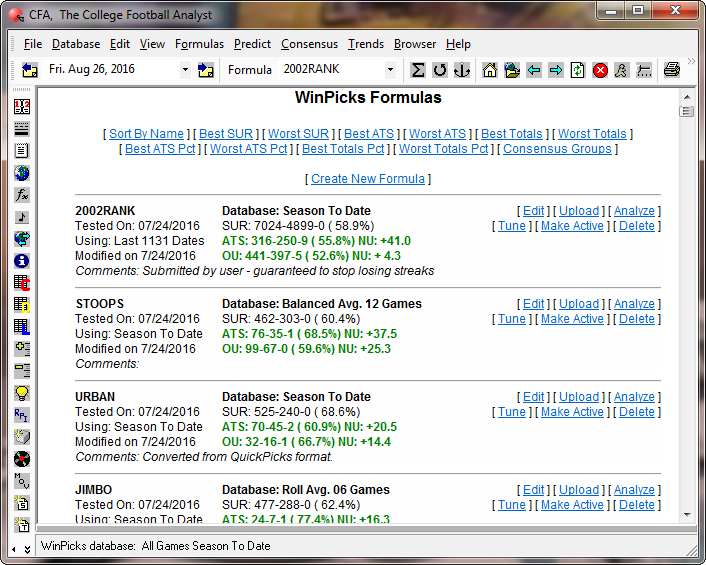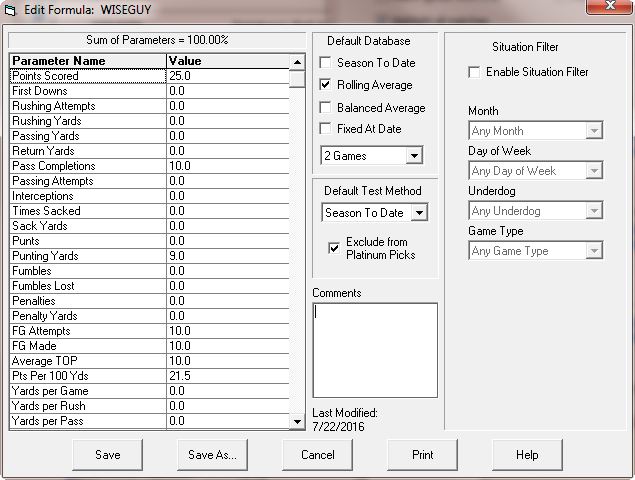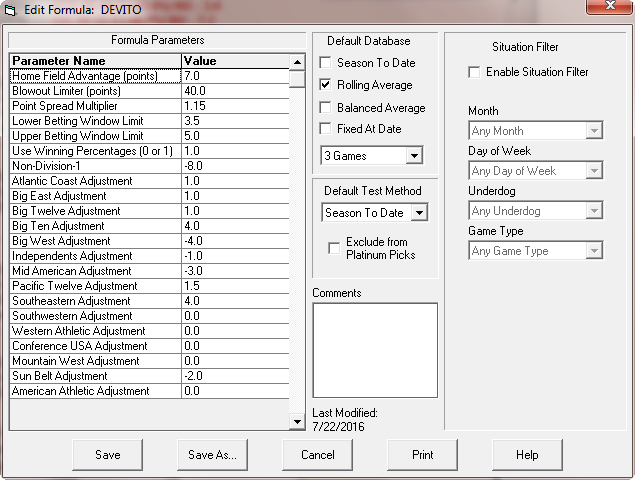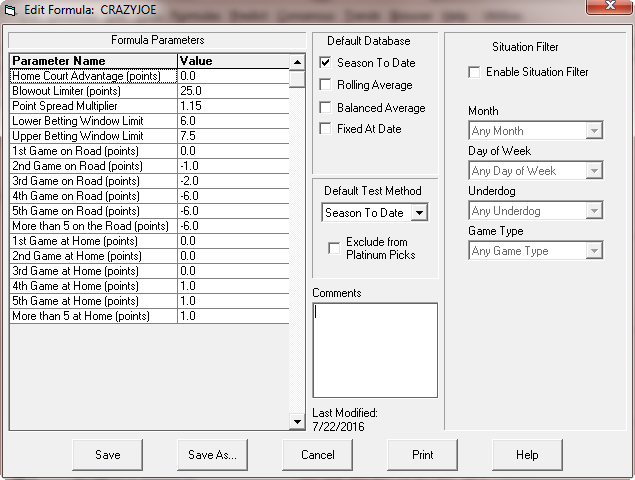WinPicks Reference Manual
Section 8.2. Using Prediction Formulas
Prediction formulas are easy to make and use. This section explains how to load, create, delete, modify, and view prediction formulas.
The My Formulas Screen
You don't have to create your own prediction formulas. Each member of the WinPicks family comes with at least three ready to use formulas. These formulas have worked well in past seasons, and you'll probably be pleased with their accuracy.
Your prediction formulas are managed using the MY FORMULAS screen. To get to this screen, select MY FORMULAS from the FORMULAS menu, or click the MY FORMULAS icon, or press the F9 key. You'll see a screen similar to Figure 8.20:

Figure 8.20 - The My Formulas Screen (CFA)
The formulas listed on the MY FORMULAS screen are sorted according to a method that you can select by clicking on the text links at the top of the screen. There are 11 different ways you can sort your formula list: by name, by best straight-up record (SUR), by worst SUR, by best against the spread (ATS) record, by worst ATS record, by best totals (over/under) record, by worst totals record, by best ATS percentage, by worst ATS percentage, by best totals percentage, and by worst totals percentage. By changing the sort method, you can explore your list of formulas and quickly find the formula that you want to find. There is also a text link on the MY FORMULAS screen that allows you to see each of your consensus formula groups, and the individual formulas within the group.
The MY FORMULAS screen contains the following information about each formula:
- The Formula Name - All formulas are stored in individual files. The screen doesn't show the file extension for the formula, but all members of the WinPicks family use unique file extensions to identify their formulas. The file extension for pro football formulas is PFF, college football formulas use CFF, and pro basketball formulas use PBF.
- The Database Method - This column lists the database method used by the formula. This information is stored inside the formula, and whenever you load a formula, it automatically selects its database method. This database method is used until you change it.
- The date when the formula was last modified.
- The date when the formula was last tested.
- The Formula's Record - The formula's straight-up (SUR), against the spread (ATS), and over/under (OU) records are shown, along with the number of net units the formula has won or lost for ATS and OU selections. These records were tabulated on the date when the formula was last tested. Whenever you start WinPicks, it will remind you to test formulas that have not been tested within the last three days. If you take advantage of these reminders, the formula records will be up to date, or nearly up to date.
- Comments - The line in italics contains comments about the formula. This line is optional, and is not included in all formulas. However, it can be used to credit the author of the formula, to provide historical information about the formula, or to provide tips or reminders on how to use the formula.
Loading Formulas
The MY FORMULAS screen lists all of the available formulas. To load a formula, select the formula that you wish, then double click the mouse or click the MAKE ACTIVE button. Or, use the box on the toolbar to select a formula.
Whenever you run WinPicks, it remembers the last formula that you used, and automatically loads the formula for you. It will continue to use the formula until you select another one.
Creating Formulas
To get the most value from WinPicks, you should create your own formulas. Your formulas might outperform ours. Plus, you'll get the satisfaction of using a method that you developed yourself.
To get started, click on the CREATE NEW FORMULA text link near the top of the MY FORMULAS screen. You are then asked to enter a name for the new formula. Enter a name for the formula then click the OK box or press ENTER. There is no limit to the length of formula names, but to prevent on-screen formatting problems, it is a good idea to limit them to 20 characters.
After you select a name, the formula editing screen will appear. The appearance of the formula editing screen (and the way you create formulas) depends upon the application you are using. However, some parameters are common to all the WinPicks applications (PFA, CFA, PBA, and CBA). The common parameters are:
- Home Field Advantage (Home Court Advantage in PBA and CBA) - This is the point spread advantage given to the home team. The default value is 3 points.
- Point Spread Multiplier - This number is multiplied by the original point spread to obtain a new point spread. It is initially set to 1. Enter a number greater than 1 to generate bigger point spreads, or a number less than 1 to generate smaller point spreads. For example, if the formula predicts a point spread of 4 with the multiplier set to 1, it becomes 6 with the multiplier set to 1.5 (4 x 1.5 = 6). By adjusting the Point Spread Multiplier, you can fine tune a formula to get the best possible results.
- Lower Betting Window Limit & Upper Betting Window Limit - These two parameters set the betting window and determine how many picks WinPicks will recommend. The betting window refers to the difference between predictions made by WinPicks, and the actual betting line. For example, if the betting window is set at 1 to 7 points, WinPicks recommends picks when the actual line differs from the WinPicks line by 1 to 7 points. The lower and upper bounds of the betting window are set using the parameters named Lower Betting Window Limit and Upper Betting Window Limit. The default betting window range is 1 to 10 points. If you increase the window, WinPicks recommends more picks. If you decrease the window, WinPicks recommends fewer picks.
- Default Database - You must select the database method that your formula will use. WinPicks will load the selected database each time the formula is activated. Keep in mind that if you change the database method (from the DATABASE menu or the toolbar) it will override the formula setting.
- Default Test Method - The "Default Test Method" is the number of dates (going back) a formula will be tested with using ANALYZE ALL FORMULAS on the FORMULA menu and the "Analyze" link on the MY FORMULAS screen. When set to "Season To Date", WinPicks will always show a formula's results for the current season only. When set to "Last n Dates", WinPicks will always show the results using the exact number of dates set. The "Default Test Method" is used by WinPicks to rank the best formulas on the MY FORMULAS screen. Note that the ANALYZE THE CURRENT FORMULA menu option will let you override this setting and try a different range of dates, but ANALYZE ALL FORMULAS and the "Analyze" link always use the default test method when testing a formula.
- Exclude from Platinum Picks - Check this box if you want the formula to be excluded from the Platinum Picks calculations. All formulas will be used by default unless this box is checked.
- Situation Filter - If you enable the situation filter (by checking the box), you can make a formula that only generates predictions in certain situations. Four different situations can be chosen. Two of them, the "Month" and "Day of Week" settings, are self explanatory. For example, you can create a formula specifically for NFL Monday night football that only makes predictions for Monday night games. The "Underdog" situation setting allows you to limit the formula to making predictions when either the home or away team is the underdog. The "Game Type" situation setting allows you to limit the formula to making predictions on division, conference, nonconference, or postseason games. This can be very powerful, because you might find that college football and basketball formulas tailored for conference games only can do especially well. You can also combine settings so that your formula only makes predictions when specific situations occur, for example, when a team is a home dog in a conference game.
The remaining parameters are different for each member of the WinPicks family. Therefore, we need to explain each type of formula separately, beginning with the formulas used by PFA.
Creating Formulas with Pro Football Analyst (PFA)
The formula editing screen for PFA (Figure 8.21) includes all the statistical categories tracked by PFA. The statistical categories are listed in the column labeled Parameter Name. You can move around the formula editing screen using the arrow keys or the mouse. Each category starts out with a 0 in the column labeled Value. The value assigned to each statistic is the percentage weight that the formula will place on that particular statistic. For example, if you enter a value of 20 for points scored, predictions are based 20% on points scored, and 80% on other statistics.
If the percentage weight is left at 0, the statistic will not be used by the formula. To use a statistic in your formula, you simply assign it a non-zero percentage weight by keying in the number you want to use.

Figure 8.21 - The Formula Editing Window for PFA
It is OK to use just a few stats in your formulas. Some stats (yards per game, points scored, points per 100 yards, winning percentage, and so on), are very important, and are assigned a high weight in many successful formulas. Other stats (punting yards, field goals attempted, return yards, and so on), are normally considered to be less important. They are usually assigned a low weight or are not used at all. At the top of the formula entry window, you'll see a number called the Sum of Parameters. This number must equal 100% before you can save the formula.
The last four items on the parameter list (Home Field Advantage, Point Spread Multiplier, Lower Betting Window Limit, and Upper Betting Window Limit) are common to all formulas and are discussed earlier in this section.
And finally, before saving the formula, you may want to type a comment in the Comments box. Adding a comment is optional, but you will probably find them useful, especially if you create a large number of formulas. When you are finished with the formula:
- Click the SAVE button to save (and load) the formula
- Click the CANCEL button to quit without saving
You can automatically create prediction formulas by using SureLock, The Formula Wizard. SureLock can be found under the ADD-INS menu and uses a multiple linear regression model to generate an optimized prediction formula. In other words, SureLock does all the work for you. The instructions for using SureLock are found in Section 11.
Creating Formulas with College Football Analyst (CFA) or College Basketball Analyst (CBA)
The formula editing screen for CFA is shown in Figure 8.22:

Figure 8.22 - The Formula Editing Window for CFA
CFA and CBA formulas are based on average margin of victory, winning percentage, and the relative strength of the Division-1 conferences. The formula editing screen for CFA has a column labeled Parameter Name and a column labeled Value. Four items on the parameter list (Home Field Advantage, Point Spread Multiplier, Lower Betting Window Limit, and Upper Betting Window Limit) are common to all formulas and are discussed earlier in this section. The remaining parameters are:
- Blowout Limiter - This number limits the significance of "blowouts", or games with one-sided scores. For example, if the blowout limiter is set to 20 (the default value), games decided by more than 20 points are given the same significance as games with a 20-point margin. In other words, if a football team wins by 70-0, the formula will assign it the same significance as a 20-0 victory. This feature prevents teams who run up the score from having an inflated power rating.
- Use Winning Percentages - To turn this option on, enter a 1. To turn it off, enter a 0 (the default). If "Use Winning Percentages" is turned on it enhances the power ratings of teams that win a high percentage of their games. Power ratings that do not take winning percentage into account will often give high ratings to teams that seldom win if they have played a tough schedule. By the same token, teams that almost always win may be ranked low if they have played a weak schedule. However, winning is often a habit for good teams (even when they play poorly), and losing is often a habit for bad teams (even when they play well). For this reason, you might want to take winning percentage into account.
- Conference Adjustments - You also need to enter a positive or negative point spread adjustment for each conference. All are set to 0 by default, but every handicapper knows that a victory over a Big 10 school has more significance than a victory over a non Division-1 school. You should add some additional points to the strongest conferences, and perhaps take points away from the weaker ones by entering negative numbers. The INTER CONFERENCE RECORDS feature provides a clear picture of the relative strength of the conferences.
And finally, before saving the formula, you may want to type a comment in the Comments box. When you are finished with the formula:
- Click the SAVE button to save (and load) the formula
- Click the CANCEL button to quit without saving
Creating Formulas with Pro Basketball Analyst (PBA)
The formula editing screen for PBA is shown in Figure 8.23:

Figure 8.23 - The Formula Editing Window for PBA
PBA formulas are based on average margin of victory, winning percentage, and the length of time that a team has spent at home or on the road. The formula editing screen for PBA has a column labeled "Parameter Name" and a column labeled "Value". Four parameters (Home Court Advantage, Point Spread Multiplier, Lower Betting Window Limit, and Upper Betting Window Limit) are common to all formulas and are discussed earlier in this section. The remaining parameters are:
- Blowout Limiter - This number limits the significance of "blowouts", or games with one-sided scores. For example, if the blowout limiter is set to its default value of 20, games decided by more than 20 points are given the same significance as games with a 20-point margin. In other words, if a team wins by 134-88, the formula will assign it the same significance as a 99-79 victory. This feature prevents teams who run up the score from having an inflated power rating.
- Weariness and Rest Adjustments - These parameters allow you to select the advantage (or disadvantage) given to a team when they are playing at home or on the road. For example, an NBA team that has played several in a row on the road is at a distinct disadvantage when playing a team that has been at home for the past few games. You can assign positive or negative point spread adjustments based on the number of consecutive games a team has played during a home stand or road trip. For example, if you assign a value of -5 to "5th Game on Road", the formula will assume that the road team has a 5 point disadvantage due to the weariness caused by playing 5 consecutive road games. Likewise, if you assign a value of 5 to "5th Game at Home", the formula assumes that the home team is well rested due to the long homestand and gives them a 5 point advantage.
And finally, before saving the formula, you may want to type a comment in the "Comments" box. When you are finished with the formula:
- Click the SAVE button to save (and load) the formula
- Click the CANCEL button to quit without saving
Modifying a Formula
You can modify any formula, including those included with WinPicks. To do so, click the EDIT link near the name of the formula that you want to modify on the MY FORMULAS screen. The formula editing screen will appear, and you can make your changes. After you finish making changes, save the formula by clicking the SAVE button, or click the SAVE AS button to save the formula with a different name. If you decide not to modify the formula, click the CANCEL button.
Deleting Formulas
To delete a formula, click the DELETE link near the name of the formula on the MY FORMULAS screen. Select
Analyzing Formulas
To quickly analyze a formula, click the ANALYZE link near the name of the formula on the MY FORMULAS screen. When the analysis is finished, a summary of the results is shown on screen. This analysis provides the same overall results as the ANALYZE THE CURRENT FORMULA feature. However, unlike ANALYZE THE CURRENT FORMULA it only shows the total results, it does shows not the results by date.
To analyze all of your formulas at once, select ANALYZE ALL FORMULAS on the FORMULA menu. After the formulas are analyzed, you are returned to the MY FORMULAS screen where the results are summarized.
Uploading Formulas
This feature allows you to upload a prediction formula, so it can be downloaded by other WinPicks users via the Formula Warehouse. In this way, WinPicks users can form a community where the best prediction formulas are shared among users, so that everyone can have the highest winning percentage possible. To use this feature, you must be connected to the Internet, and you must have already entered your WinPicks Customer ID. If you haven't done so, see Section 2 for instructions. It takes just seconds to upload a formula; click the UPLOAD link near the name of the formula on MY FORMULAS screen, and the formula will be automatically uploaded.
Viewing Formulas
You can view the contents of the active prediction formula by selecting FORMULA from the VIEW menu. When you are finished viewing the formula, select



